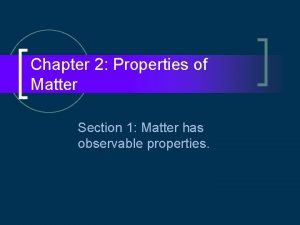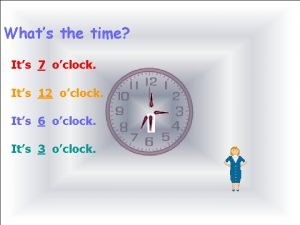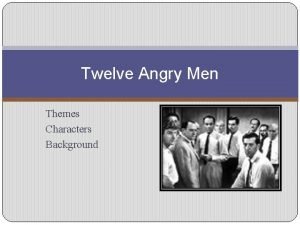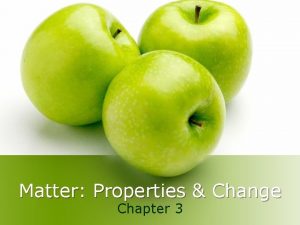Chapter Twelve Properties of Matter 12 1 Properties

















- Slides: 17


Chapter Twelve: Properties of Matter Ø 12. 1 Properties of Solids Ø 12. 2 Properties of Fluids Ø 12. 3 Buoyancy

12. 3 Buoyancy is a force ØBuoyancy is a measure of the upward force a fluid exerts on an object that is submerged. The water in the pool exerts an upward force that acts in a direction opposite to the boy’s weight.

12. 3 Volume and buoyancy ØThe strength of the buoyant force on an object in water depends on the volume of the object that is underwater. As you keep pushing downward on the ball, the buoyant force gets stronger and stronger. Which ball has more volume underwater?

12. 3 Weight and buoyancy ØWeight is a force, like any other pushing or pulling force, and is caused by Earth’s gravity. ØIt is easy to confuse mass and weight, but they are not the same. What is the rock’s weight? ØWeight is the downward force of gravity acting on mass. What is the rock’s mass?

12. 3 Weight and buoyancy ØIn the third century BC, a Greek mathematician named Archimedes realized that buoyant force is equal to the weight of fluid displaced by an object. ØA simple experiment can be done to measure the buoyant force on a rock with a spring scale when it is immersed in water.


12. 3 Weight and buoyancy ØIn air the buoyant force on the rock is 29. 4 N. ØWhen the rock was submerged, the scale read 19. 6 N. ØThe difference is a force of 9. 8 N, exactly the amount of force the displaced water exerts.

12. 3 Weight and buoyancy These blocks are the same total volume. Which block has more buoyant force acting on it? Which block weighs more in air?

12. 3 Weight and buoyancy ØBuoyancy explains why some objects sink and others float. ØWhether an object sinks or floats depends on how the buoyant force compares with the weight.

12. 3 Density and buoyancy ØIf you know an object’s density you can quickly predict whether it will sink or float. Which ball will sink in water? Which ball will float in water?

12. 3 Density and buoyancy Average density helps determine whether objects sink or float. Ø An object with an average density GREATER than the density of water will sink. Ø An object with an average density LESS than the density of water will float.

12. 3 Density and buoyancy What can you say about the average density of these blocks?

12. 3 Density and buoyancy ØWhen they are completely underwater, both balls have the same buoyant force because they displace the same volume of water.


12. 3 Boats and average density ØUse your understanding of average density to explain how steel boats can be made to float.

12. 3 Boats and average density ØIf you have seen a loaded cargo ship, you might have noticed that it sat lower in the water than an unloaded ship nearby. ØThis means a full ship must displace more water (sink deeper) to make the buoyant force large enough to balance the ship’s weight.
 Funny tongue twisters
Funny tongue twisters Chapter 2 section 1 classifying matter answers
Chapter 2 section 1 classifying matter answers 2 properties of matter
2 properties of matter Chapter 2 properties of matter answer key
Chapter 2 properties of matter answer key Section 1 composition of matter
Section 1 composition of matter Meysam golmohammadi
Meysam golmohammadi Section 1 composition of matter
Section 1 composition of matter Label the cranial dura septa and associated sinuses.
Label the cranial dura septa and associated sinuses. Classification of matter section 1 composition of matter
Classification of matter section 1 composition of matter Gray matter and white matter
Gray matter and white matter Gray matter
Gray matter Flow of energy vs flow of matter
Flow of energy vs flow of matter Its 12 o clock
Its 12 o clock What are the terrible twelve water pollution
What are the terrible twelve water pollution Twelve corners middle school
Twelve corners middle school 12 angry men themes
12 angry men themes 450 bc rome
450 bc rome What were the twelve tables
What were the twelve tables

































